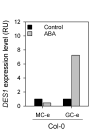Analysis of Guard Cell Readouts Using Arabidopsis thaliana Isolated Epidermal Peels
- PMID: 39100596
- PMCID: PMC11292165
- DOI: 10.21769/BioProtoc.5033
Analysis of Guard Cell Readouts Using Arabidopsis thaliana Isolated Epidermal Peels
Abstract
Stomata are pores surrounded by a pair of specialized cells, called guard cells, that play a central role in plant physiology through the regulation of gas exchange between plants and the environment. Guard cells have features like cell-autonomous responses and easily measurable readouts that have turned them into a model system to study signal transduction mechanisms in plants. Here, we provide a detailed protocol to analyze different physiological responses specifically in guard cells. We describe, in detail, the steps and conditions to isolate epidermal peels with tweezers and to analyze i) stomatal aperture in response to different stimuli, ii) cytosolic parameters such as hydrogen peroxide (H2O2), glutathione redox potential (E GSH), and MgATP-2 in vivo dynamics using fluorescent biosensors, and iii) gene expression in guard cell-enriched samples. The importance of this protocol lies in the fact that most living cells on epidermal peels are guard cells, enabling the preparation of guard cell-enriched samples. Key features • Isolation of epidermal peels as a monolayer enriched in guard cells • Measurement of cytosolic guard cell signaling component dynamics in isolated epidermal peels through fluorescent biosensor analysis • Gene expression analysis of guard cell-enriched isolated tissue.
Keywords: Arabidopsis thaliana; Biosensors; Epidermal peels; Guard cells; RNA; Stomatal aperture.
©Copyright : © 2024 The Authors; This is an open access article under the CC BY-NC license.
Conflict of interest statement
Competing interestsThe authors declare no competing interests.
Figures





Similar articles
-
Metabolomics of red-light-induced stomatal opening in Arabidopsis thaliana: Coupling with abscisic acid and jasmonic acid metabolism.Plant J. 2020 Mar;101(6):1331-1348. doi: 10.1111/tpj.14594. Epub 2019 Dec 15. Plant J. 2020. PMID: 31677315
-
Preparation of Epidermal Peels and Guard Cell Protoplasts for Cellular, Electrophysiological, and -Omics Assays of Guard Cell Function.Methods Mol Biol. 2016;1363:89-121. doi: 10.1007/978-1-4939-3115-6_9. Methods Mol Biol. 2016. PMID: 26577784
-
Ethylene Inhibits Methyl Jasmonate-Induced Stomatal Closure by Modulating Guard Cell Slow-Type Anion Channel Activity via the OPEN STOMATA 1/SnRK2.6 Kinase-Independent Pathway in Arabidopsis.Plant Cell Physiol. 2019 Oct 1;60(10):2263-2271. doi: 10.1093/pcp/pcz121. Plant Cell Physiol. 2019. PMID: 31241163
-
Abscisic acid and CO2 signalling via calcium sensitivity priming in guard cells, new CDPK mutant phenotypes and a method for improved resolution of stomatal stimulus-response analyses.Ann Bot. 2012 Jan;109(1):5-17. doi: 10.1093/aob/mcr252. Epub 2011 Oct 12. Ann Bot. 2012. PMID: 21994053 Free PMC article. Review.
-
Stomatal development in the context of epidermal tissues.Ann Bot. 2021 Jul 30;128(2):137-148. doi: 10.1093/aob/mcab052. Ann Bot. 2021. PMID: 33877316 Free PMC article. Review.
Cited by
-
Viewing Stomata in Action: Autonomous in Planta Imaging of Individual Stomatal Movement.Plant Cell Environ. 2025 Jun;48(6):4533-4549. doi: 10.1111/pce.15436. Epub 2025 Mar 2. Plant Cell Environ. 2025. PMID: 40025844 Free PMC article.
References
-
- WEYERS J. D. B. and TRAVIS A. J.(1981). Selection and Preparation of Leaf Epidermis for Experiments on Stomatal Physiology. J Exp Bot. 32(4): 837 850 850. 10.1093/jxb/32.4.837 - DOI
LinkOut - more resources
Full Text Sources

